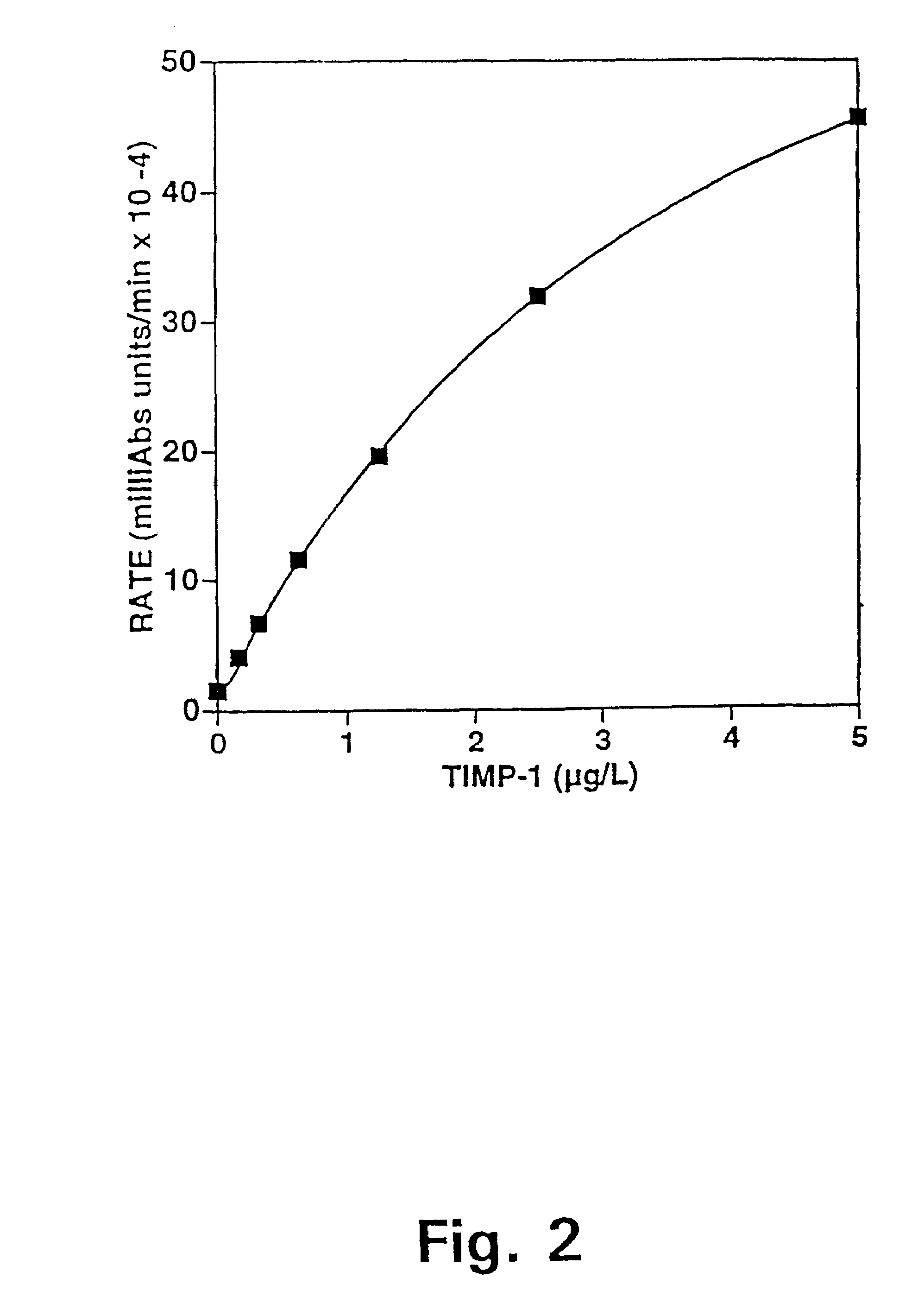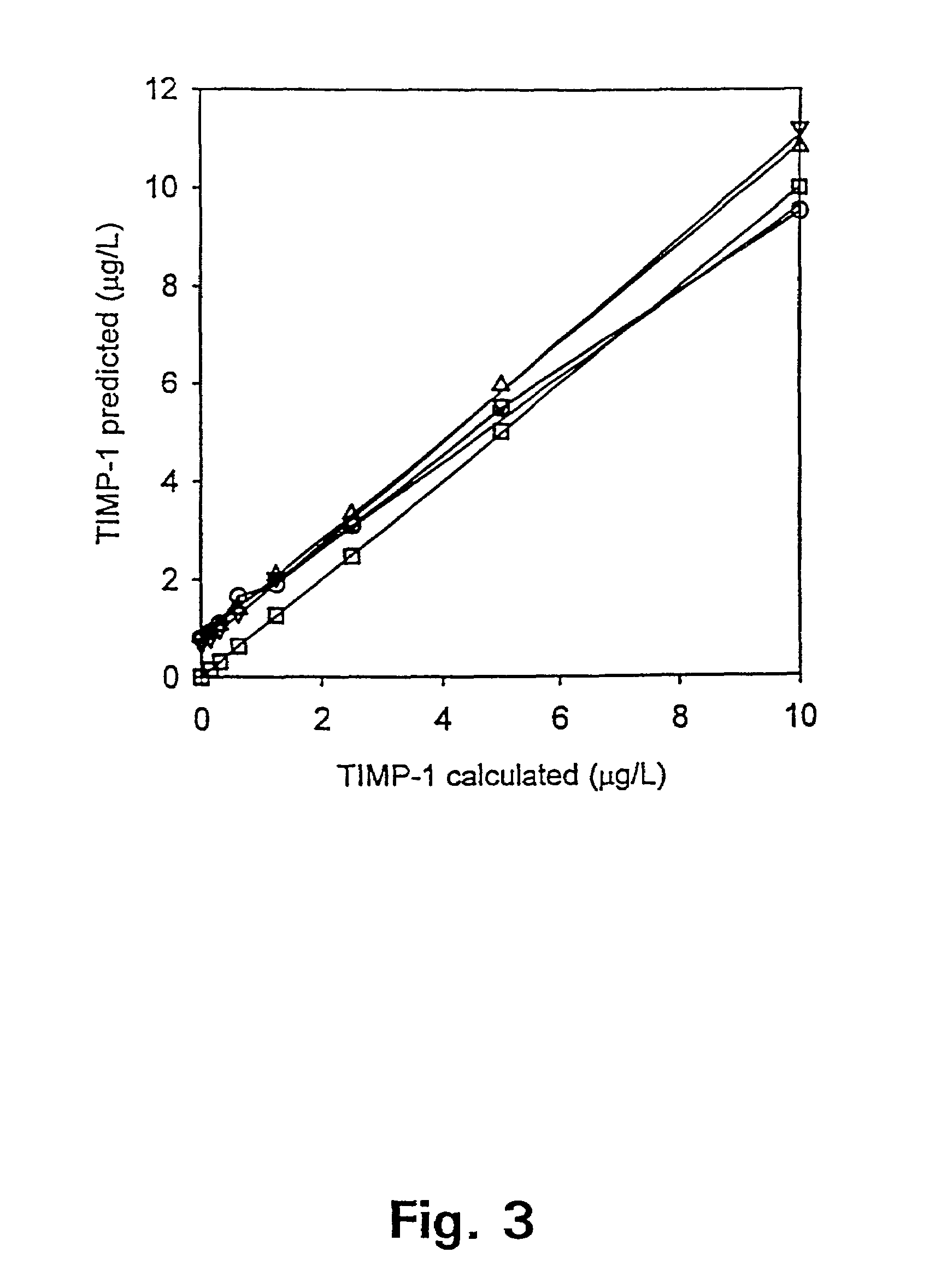Tissue inhibitor of matrix metalloproteinases type-1 (TIMP-1) as a cancer marker and postoperative marker for minimal residual disease or recurrent disease in patients with a prior history of cancer
a matrix metalloproteinase and tissue inhibitor technology, applied in the field of tissue inhibitors of matrix metalloproteinases type-1 (timp-1), can solve the problems of low sensitivity, lack of compliance of current tests, and significant risk of disease death, and achieve the effect of equal clinical value and level of specificity of invention
- Summary
- Abstract
- Description
- Claims
- Application Information
AI Technical Summary
Benefits of technology
Problems solved by technology
Method used
Image
Examples
example 1
[0113]Preparation of an ELISA to quantitate total TIMP-1 concentrations in human plasma.
[0114]This example describes the preparation and validation of an ELISA that measures total TIMP-1 levels in plasma. In addition, this example provides information on TIMP-1 levels in different plasma preparations as well as in healthy blood donors of both sexes.
Materials and Methods
Blood Donors
[0115]Blood samples were initially obtained from 94 apparently healthy volunteer blood donors, comprising 51 males aged 19 to 59 years (median: 41 years) and 43 females aged 20 to 64 years (median: 36 years). In a subsequent collection, 100 donor samples were obtained, comprising 56 males aged 19 to 59 years (median 42: years) and 44 females aged 20 to 60 years (median: 36.5 years). Informed consent was obtained from all donors, and permission was obtained from the local Ethical Committees.
Blood Collections and Plasma Separation
[0116]Peripheral blood was drawn with minimal stasis (if necessary a maximum of...
example 2
[0136]Preparation of an ELISA to quantitate TIMP-1:MMP-9 complexes in plasma.
[0137]The following example describes an assay to determine the concentration of TIMP-1:MMP-9 complexes in body fluids. The assay is used with plasma samples of healthy blood donors in order to establish normal ranges of this complex (Holten Andersen et. al., 1999).
Materials and Methods
TIMP-1: MMP-9 Complex ELISA
[0138]A sensitive and specific sandwich ELISA was prepared using the above-described TIMP-1 antibody, MAC-15, and a rabbit MMP-9 polyclonal antibody developed in the Hematological Department, Rigshospitalet, Denmark (Kjeldsen et. al., 1992). The MMP-9 antibody was used for antigen capture and MAC-15was used for antigen detection. A rabbit anti-mouse-Ig / alkaline phosphatase conjugate (DAKO®, Glostrup, Denmark) enabled a kinetic rate assay (FIG. 8). The latter conjugate was supplied preabsorbed against human IgG, thus eliminating cross-reactivity with IgG in the plasma samples. The MMP-9 antibody capt...
example 3
[0146]Preparation of an ELISA to quantitate free TIMP-1 levels in plasma.
[0147]The following example describes an assay that determines the concentration of free TIMP-1 levels in body fluids. The assay is applied to plasma samples of healthy blood donors in order to establish normal ranges of free TIMP-1.
Materials and Methods
FREE TIMP-1 ELISA
[0148]A sensitive and specific sandwich immunoassay was prepared, using a TIMP-1 monoclonal IgG1 antibody (MAC-19) developed at the Strangeways Laboratories, England (Cooksley et. al., 1990) and a sheep polyclonal anti-TIMP-1 antibody. The sheep polyclonal anti-TIMP-1 antibody was used for antigen capture and the murine monoclonal MAC-19 was used for antigen detection. A rabbit anti-mouse-Ig / alkaline phosphatase conjugate was the secondary detection reagent (FIG. 9). The latter conjugate was supplied preabsorbed against human IgG, thus eliminating cross-reactivity with IgG in the plasma samples. The MAC-19 monoclonal antibody is completely speci...
PUM
| Property | Measurement | Unit |
|---|---|---|
| time | aaaaa | aaaaa |
| time | aaaaa | aaaaa |
| time | aaaaa | aaaaa |
Abstract
Description
Claims
Application Information
 Login to View More
Login to View More - R&D
- Intellectual Property
- Life Sciences
- Materials
- Tech Scout
- Unparalleled Data Quality
- Higher Quality Content
- 60% Fewer Hallucinations
Browse by: Latest US Patents, China's latest patents, Technical Efficacy Thesaurus, Application Domain, Technology Topic, Popular Technical Reports.
© 2025 PatSnap. All rights reserved.Legal|Privacy policy|Modern Slavery Act Transparency Statement|Sitemap|About US| Contact US: help@patsnap.com



